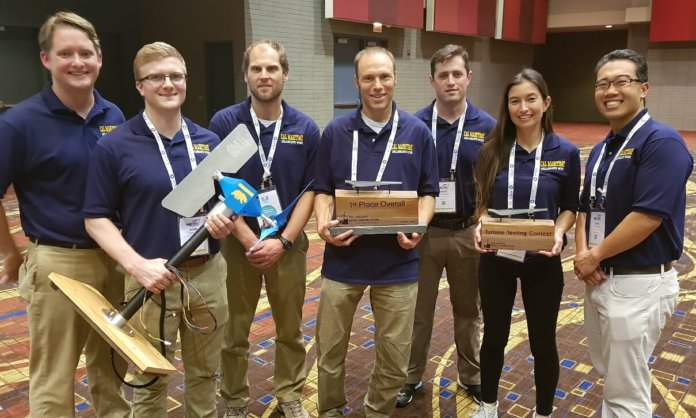The California State University Maritime Academy (Cal Maritime) beat out 11 other teams to claim top honors at the third biennial Collegiate Wind Competition, held by the U.S. Department of Energy (DOE) at the American Wind Energy Association’s annual WINDPOWER Conference, held last week in Chicago.
According to the DOE, the Collegiate Wind Competition provides undergraduates with real-world skills needed to enter the renewable energy workforce. Competitors were challenged with a number of tasks, including developing and delivering a business plan, siting a wind plant, and building and testing a wind turbine.
“The students participating in the Collegiate Wind Competition represent the best and brightest that our nation has to offer,” says Tim Unruh, deputy assistant secretary for renewable power at the DOE. “As the U.S. wind industry continues to grow, the Collegiate Wind Competition provides unique, hands-on training and an opportunity to help launch the careers of the next generation of wind energy professionals.”
A panel of wind industry experts named Cal Maritime the overall winner of the competition with the highest cumulative scores in all categories. The team’s turbine will be displayed at the DOE’s headquarters in Washington, D.C., in the coming months.
The Pennsylvania State University came in second place, and Kansas State University came in third. Below are the winners of each contest:
- Turbine Testing Award: Cal Maritime
- Technical Design Award: Virginia Tech
- Business Plan Award: James Madison University
- Siting Challenge Award: University of Wisconsin – Madison
- People’s Choice Award: Universidad del Turabo (Puerto Rico)
- Resiliency Award: Universidad del Turabo
“Every year that Cal Maritime has participated, we’ve gotten better at this competition. Progressively through all of these years, our students have looked back on past designs and thought processes,” says Ryan Storz, a Cal Maritime faculty representative who managed and advised the team. “This year is an exemplary example of what shipmates are: We had mechanical engineers, a licensed mechanical engineer, a marine engineering technology student, three global studies and maritime affairs students, and four business students on this team.”





The Wind turbine industry uses the radial bladed rotors as the standard model. I have noticed that rotor mass varies as the cube of the bladed length. Hence, the DOE rated 50 MW
unit could not be developed.
When we modified the rotor as the Helical bladed rotor, it yielded a very light weighted rotor.
US 9,537,371 B2.
I appreciate any suggestions.
Thank you.
ka@wtswind.com